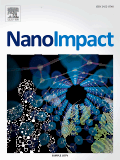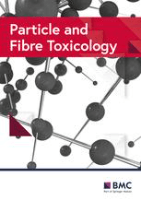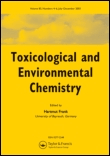
NanoImpact
Scope & Guideline
Uncovering the Dual Nature of Nanomaterials
Introduction
Aims and Scopes
- Nanomaterial Toxicity Assessment:
Research on the toxicological effects of nanomaterials, including in vitro and in vivo studies, to understand their impact on various biological systems. - Environmental Fate and Behavior of Nanomaterials:
Investigation into how nanomaterials behave in different environmental settings, including their transport, transformation, and degradation. - Risk Assessment and Governance:
Development of frameworks and methodologies for assessing the risks associated with nanomaterials, focusing on regulatory aspects and safety by design. - Innovative Analytical Techniques:
Advancements in analytical methods for the detection, characterization, and quantification of nanomaterials in various matrices. - Applications of Nanotechnology in Agriculture:
Exploration of how nanotechnology can improve agricultural practices, enhance crop yields, and address food security challenges.
Trending and Emerging
- Microplastics and Nanoplastics Research:
An increasing number of studies are investigating the impact of microplastics and nanoplastics on both environmental systems and biological organisms, highlighting a growing concern about plastic pollution. - Sustainable Nanotechnology Development:
There is a notable trend towards exploring sustainable practices in nanotechnology, including safe-by-design approaches and innovations that aim to minimize environmental impact. - Interdisciplinary Approaches to Nanosafety:
Research integrating multiple disciplines, such as toxicology, ecology, and engineering, is gaining traction, reflecting the need for comprehensive strategies in nanomaterial safety assessment. - Impact of Nanomaterials on Soil and Agriculture:
Studies focusing on the effects of nanomaterials on soil health and agricultural productivity are becoming more prevalent, indicating a shift towards understanding their role in food systems. - Health Implications of Nanoparticle Exposure:
Research on the health effects of exposure to various nanomaterials, particularly in relation to chronic diseases and occupational health risks, is increasingly prominent.
Declining or Waning
- Basic Research on Nanomaterial Properties:
There has been a noticeable decrease in studies focused solely on the fundamental properties of nanomaterials, as the journal's emphasis has shifted towards applied research with direct implications for health and environmental safety. - Historical Analysis of Nanomaterial Legislation:
Papers discussing historical perspectives on nanomaterial regulations have become less frequent, indicating a shift towards current and future regulatory frameworks rather than retrospectives. - Nanosafety in Controlled Environments:
Research focused on the nanosafety of materials in controlled laboratory settings is waning, with more emphasis on real-world applications and field studies.
Similar Journals

Environmental Chemistry and Ecotoxicology
Connecting research and practice in environmental chemistry.Environmental Chemistry and Ecotoxicology, published by KEAI PUBLISHING LTD, is a pioneering Open Access journal that has been at the forefront of research since its establishment in 2019. With an impressive trajectory that converges research excellence until 2024, the journal focuses on critical developments in the fields of environmental chemistry and ecotoxicology. It boasts a commendable market position, ranking in the top 3% among leading journals in Agricultural and Biological Sciences, Environmental Science, and related disciplines, as demonstrated by its high Scopus ranks. The journal is committed to disseminating groundbreaking research that addresses the pressing challenges of environmental sustainability and chemical safety, making it an essential resource for researchers, professionals, and students aiming to navigate the complexities of our ecological landscapes. By embracing an Open Access model, the journal ensures that valuable insights are accessible to a global audience, fostering collaboration and innovation in the field.

Journal of Health and Safety at Work
Transforming workplace safety with pioneering insights.The Journal of Health and Safety at Work, published by the Iranian Occupational Health Association, is a vital resource for researchers, professionals, and students engaged in the fields of occupational health, safety, and environmental management. With an ISSN of 2251-807X and E-ISSN 2383-2088, this Open Access journal has been dedicated to disseminating knowledge since 2012, ensuring that critical research is accessible to a global audience. The journal’s scope encompasses a diverse range of topics including human factors and ergonomics, safety research, and public health, with a focus on enhancing workplace safety and environmental standards. Although currently positioned in the Q4 category across various disciplines within safety and health research, the journal offers a unique platform for emerging studies and innovative practices, making it a significant contributor to the discourse in these fields. The journal's commitment to open access aligns with the growing trend of transparent scholarship, thus facilitating the sharing of vital insights to improve workplace health and safety outcomes. Researchers aiming to publish groundbreaking studies in this pivotal area will find the Journal of Health and Safety at Work an indispensable avenue for advancing knowledge and fostering professional collaboration.

Current Research in Toxicology
Advancing Knowledge for a Safer FutureCurrent Research in Toxicology is a pioneering journal published by ELSEVIER that serves as a vital platform for disseminating cutting-edge research in the field of toxicology, spanning from biological impacts to pharmacological applications. With an ISSN of 2666-027X and an impressive Q2 ranking in key categories such as Applied Microbiology and Biotechnology, Health, Toxicology and Mutagenesis, and Toxicology, this journal underscores its commitment to high-quality research and significant contributions to the scientific community. Based in the Netherlands, Current Research in Toxicology aims to bridge the gap between academia and industry by providing rigorously peer-reviewed articles that cover a wide array of topics including novel methodologies, regulatory challenges, and emerging trends within the domain. The journal is accessible through various platforms, making it essential for researchers, professionals, and students eager to stay updated on the latest findings and advancements in toxicology. With a comprehensive focus on integrating theory with practical application, this journal is poised to influence future studies and policies in health and environmental science.

World Mycotoxin Journal
Elevating the discourse on mycotoxins in food science and beyond.The World Mycotoxin Journal, published by Wageningen Academic Publishers, stands at the forefront of research in the field of mycotoxins, drawing particular attention to their implications in food science, public health, and environmental safety. With an ISSN of 1875-0710 and an E-ISSN of 1875-0796, this journal has continuously contributed to advancing knowledge since its inception and will remain a vital source of information through 2024. Ranked in Q2 within Food Science and achieving notable positions in Public Health and Toxicology, it offers an impactful forum for scholars and professionals worldwide. The journal’s Scopus rankings reflect its importance, with Public Health receiving a 68th percentile ranking, further underscoring the relevance of mycotoxin research in mitigating health risks. Researchers and students alike will benefit from its rigorous peer-reviewed articles, providing access to cutting-edge studies and overviews that address the complexities of mycotoxins and their far-reaching effects.

Particle and Fibre Toxicology
Leading the charge in toxicological research.Particle and Fibre Toxicology is a leading open-access journal dedicated to advancing the field of toxicology, specifically focusing on the health impacts of particulate matter and fibers. Published by BMC since 2004, this journal operates from its offices in the United Kingdom and has gained significant recognition in the scientific community, achieving an impressive impact factor that highlights its relevance and influence. As indicated by its Q1 ranking in various categories including Health, Toxicology and Mutagenesis and Medicine (miscellaneous), it occupies a prestigious position in the academic landscape, appealing to researchers, professionals, and students alike. With a Scopus ranking of #4 in Toxicology and #7 in Environmental Science, the journal ensures high visibility and accessibility, providing a platform for the dissemination of key research findings and innovative methodologies in the interdisciplinary domains of toxicology. Through its commitment to open access, Particle and Fibre Toxicology fosters knowledge-sharing and collaboration, facilitating significant advancements in our understanding of the toxicological effects of environmental agents.

TOXICOLOGICAL AND ENVIRONMENTAL CHEMISTRY
Exploring the impacts of pollutants on our environment and well-being.TOXICOLOGICAL AND ENVIRONMENTAL CHEMISTRY is a pivotal journal published by Taylor & Francis Ltd, addressing critical intersections between environmental chemistry and toxicology since its inception in 1979. With its ISSN 0277-2248 and E-ISSN 1029-0486, the journal serves as a platform for rigorous research and innovative methodologies in pollution control, health implications of environmental chemicals, and the broader spectrum of toxicological studies. Although it currently does not offer open access, the journal's impact in the field is underscored by its Category Quartiles rankings in 2023, placing it in Q3 across Environmental Chemistry, Health, Toxicology and Mutagenesis, and Pollution categories. Furthermore, its Scopus rankings reveal its significant role within the scientific community, specifically in areas such as Environmental Science and Toxicology. The journal aspires to foster multidisciplinary dialogue and advance knowledge that contributes to environmental sustainability and public health, making it an essential resource for researchers, professionals, and students dedicated to these fields.

Mycotoxin Research
Innovative Research for Health and EnvironmentMycotoxin Research, published by Springer Heidelberg, is a vital interdisciplinary journal dedicated to the exploration and study of mycotoxins, their impacts on health and environment, as well as strategies for mitigation. With a solid presence in the fields of Biotechnology, Microbiology, and Toxicology, it has earned a respectable Q3 ranking and continues to facilitate the dissemination of impactful research from 1985 through to 2024. The journal caters to a diverse audience, including researchers, professionals, and students, providing a platform for original research articles, reviews, and case studies that contribute to the understanding and management of mycotoxins. Although it does not offer open-access options, the journal remains a critical resource, engaging its readers with cutting-edge findings and advancements that shape the future of health and safety regarding mycotoxin exposure. With Scopus rankings reflecting its relevance—44th in Toxicology, 113th in Biotechnology, and 71st in Microbiology—Mycotoxin Research stands as an essential publication for anyone dedicated to advancing knowledge in these critical scientific domains.

BULLETIN OF ENVIRONMENTAL CONTAMINATION AND TOXICOLOGY
Exploring the nexus of contamination and public safety.BULLETIN OF ENVIRONMENTAL CONTAMINATION AND TOXICOLOGY, published by SPRINGER, is a pivotal journal in the fields of Environmental Science, Toxicology, and Public Health. With a strong history of dissemination since its inception in 1966, the journal predominantly focuses on the latest advances in understanding environmental contaminants and their toxicological effects on health and ecosystems. It currently holds a respectable Q2 ranking across multiple categories including Health, Toxicology and Mutagenesis, Medicine (miscellaneous), and Pollution, as per the 2023 metrics. While the journal is not Open Access, it provides an invaluable platform for researchers, professionals, and students seeking to contribute to and stay informed on critical issues regarding environmental hazards and their implications. With an engaged community of scholars and practitioners, this journal continues to be an essential resource for addressing the pressing challenges of environmental contamination and its health impacts, guiding future research and policy decisions.

PROCESS SAFETY AND ENVIRONMENTAL PROTECTION
Driving excellence in safety management and environmental protection.PROCESS SAFETY AND ENVIRONMENTAL PROTECTION, published by Elsevier, is a premier academic journal dedicated to advancing the fields of chemical engineering, environmental science, and safety management. With an impressive impact factor, this esteemed journal undergoes a meticulous peer-review process and serves as a vital platform for researchers, professionals, and students seeking to disseminate cutting-edge research and innovative practices. Submissions are welcome in a wide scope of topics related to safety, risk, reliability, and environmental engineering, demonstrating its influence as a Q1 journal across multiple categories, including Environmental Chemistry and Safety, Risk, Reliability and Quality. By providing a rigorous analysis of current challenges and solutions in the domain since its inception in 1990, it continues to foster interdisciplinary collaboration and practical applications in the United Kingdom and beyond. With the journal not currently offering Open Access options, subscribers gain exclusive access to pivotal insights that shape industry standards and drive advancements in sustainable practices.

ECOTOXICOLOGY AND ENVIRONMENTAL SAFETY
Advancing knowledge at the intersection of toxicology and ecology.ECOTOXICOLOGY AND ENVIRONMENTAL SAFETY, published by Academic Press Inc. Elsevier Science, stands as a premier journal in the field of environmental science, specializing in the intricate relationships between toxic substances and ecological systems. With a commendable impact factor and recognized as a Q1 journal in various categories including Health, Toxicology and Mutagenesis, and Public Health, it consistently ranks among the top publications in Scopus, placing it in the 96th percentile for Medicine and Public Health. Established in 1977, this journal addresses critical issues related to environmental safety and pollution, making it an essential resource for researchers, professionals, and students alike. Although it does not offer an open access option, the journal’s commitment to publishing rigorous and impactful research makes it a vital platform for advancing the understanding of ecotoxicological risk assessments and environmental protection strategies. For those dedicated to the intersection of science and public health, ECOTOXICOLOGY AND ENVIRONMENTAL SAFETY serves as a beacon of knowledge and innovative research.